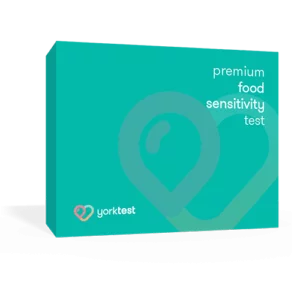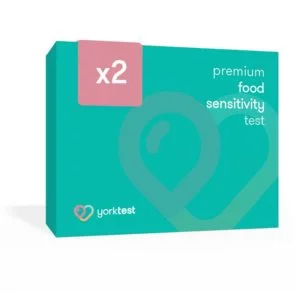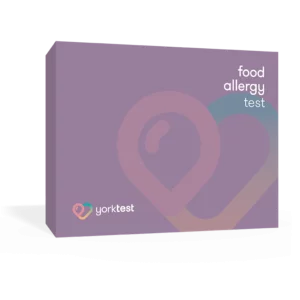- What is a Potato Allergy?
- Is this a common food allergy?
- Who is most at risk of developing a potato allergy?
- What are the Signs and Symptoms of Potato Allergy?
- Potato Allergy vs. Potato Sensitivity
- What Foods to Avoid with an Allergy to Potatoes?
- How to Test for Potato Allergy
- Potato Allergy Treatment and Management Options
- Pinpoint Your Potato Sensitivities with YorkTest
While not as prevalent as other food allergies, a potato allergy can still cause considerable impact on quality of life for those it affects. Pinpointing a potato allergy isn’t always easy, as the symptoms may be misidentified as potato intolerance or sensitivity, which are very different reactions.
If you think that potatoes are upsetting your gut and triggering symptoms, this guide can help. We’ll outline the symptoms of a potato allergy, the differences between an allergy and a sensitivity, other cross-reactive foods you should be mindful of consuming and ways to test for and manage a potato allergy in your day-to-day life.
What is a Potato Allergy?
An allergic reaction to potato occurs when the immune system misidentifies certain proteins in potatoes, like patatin, lectins and protease inhibitors, as dangerous and invasive. Patatin is thought to be the primary protein responsible for this reaction – it makes up approximately 40% of the total soluble protein content in potatoes.
Is this a common food allergy?
Compared to other food allergies such as peanuts or eggs, potato allergy does not appear to be particularly widespread. Although there haven’t been concentrated studies in the U.S., other developed countries like France and Germany have conducted large-scale studies on potato allergy prevalence.
A large study conducted in France sought to understand potato allergy and sensitization rates. The study found that about 10% of the 20,000 subjects evaluated were sensitized to raw or cooked potatoes. Another German study evaluating the prevalence of food allergies in 13,300 residents in Berlin found that, among 2,298 individuals with reported food allergies, 19.3% of them were found to have positive reactions to skin prick tests for raw potatoes.
While these percentages may seem high, the problem with these studies is that they don’t demonstrate the true rate of potato allergy against the entire population. Rather, they are select populations that already showed signs of food sensitivities.
Who is most at risk of developing a potato allergy?
Potato allergies can affect people of all ages. But this allergy has been more commonly observed in certain groups, including:
- Individuals with an allergy to a plant-based food may be at risk of developing a potato allergy due to cross-reactivity, where proteins in different foods share similar structures and trigger the same immune response. This phenomenon is known as cross-reactivity and occurs when proteins found in different foods share similar structures, causing the immune system to react similarly.
- Young children who have atopic dermatitis
- Individuals with a latex allergy. A latex allergy can trigger something called latex-fruit syndrome, which is shown to have moderate cross-reactivity with potatoes.
Individuals with Oral Allergy Syndrome (OAS) may develop symptoms upon eating potatoes if they’re allergic to birch pollen because of cross-reactive proteins between these two sources.
If you suspect you have a more complex allergy syndrome, then you should seek medical advice from your primary care physician or an allergist.
What are the Signs and Symptoms of Potato Allergy?
The signs and symptoms of a potato allergy can take between 45 minutes to an hour after consumption or contact. In some cases, peeling potatoes or even just inhaling potato particles can cause an allergic reaction.
Symptoms vary in severity from person to person. While some individuals may experience mild allergy symptoms, others may require emergency medical attention. Additionally, certain forms of potatoes (e.g. raw versus cooked) can cause varying intensities of symptoms.
The most common potato allergy symptoms include:
- Itchy mouth, tongue, lips, ears, or throat
- Swelling in the mouth area
- Scratchy feeling in the throat
- Hives
- Breathing problems
- Swollen skin
- Cough
- Sore throat
- Sneezing
- Runny nose
- Tightness in the chest
In extreme cases, individuals with a potato allergy might experience more severe reactions like anaphylaxis. Anaphylaxis is a life-threatening condition that requires immediate medical attention. The following are potential indicators of anaphylactic shock:
- Difficulty breathing or shortness of breath
- Chest pain or tightness
- Rapid heartbeat
- Dizziness or lightheadedness
- Sudden drop in blood pressure (hypotension)
- Swelling of the face, tongue, or throat causing difficulty swallowing (angioedema)
If you suspect you’re experiencing a severe allergic reaction to potatoes and exhibit any combination of these symptoms – especially if they worsen over time – it’s important that you seek emergency medical attention immediately.
Potato Allergy vs. Potato Sensitivity
It’s important to note that a true potato allergy differs from a potato intolerance or sensitivity. Here are some of the key differences to remember:
- A potato allergy elicits an IgE antibody immune response whereas a sensitivity triggers an IgG antibody response.
- Symptoms of an allergic reaction can begin immediately, or shortly after, contact with a trigger allergen. On the other hand, symptoms of potato sensitivity can take several hours even days to appear.
- The typical profile of symptoms differs. Whilst a potato allergy is linked to swelling, itching and sneezing, a potato sensitivity is more likely to trigger symptoms such as:
- Diarrhea
- Bloating
- Skin conditions e.g. eczema or psoriasis
- Headaches
- Fatigue
If you’re experiencing any of the symptoms on the list above, we recommend taking a Premium Food Sensitivity Test to see whether potatoes are triggering an IgG reaction in your body.
Sensitivities are more common than allergies – and, good news, they are also less severe! If you have a food allergy, then it’s recommended that you avoid that food for the rest of your life. With a potato sensitivity, you may be able to reintroduce potatoes into your diet after an elimination diet and under the advice of a nutrition professional.
What Foods to Avoid with an Allergy to Potatoes?
If you have a potato allergy, it is crucial to be aware of the various foods and ingredients that may contain potatoes or potato-derived substances. By avoiding these items, you can prevent allergic reactions and maintain your overall health. Here are some common foods and ingredients to avoid:
- Potato chips: This popular snack food often contains high amounts of potatoes.
- French fries: Many French fry products use potatoes as their primary ingredient.
- Potato starch: Found in many processed foods, such as baked goods and sauces, this ingredient is derived from potatoes.
- Sweet potatoes: Although not technically related to regular white potatoes, sweet potatoes may cause cross-reactivity in individuals with a potato allergy.
- Vodka and spirits made from potatoes: Some vodka and spirits use fermented potato mash instead of grains during production.
- Certain medications and supplements: Some over-the-counter drugs or dietary supplements might contain potato-based ingredients like starches or fillers. Always check labels carefully before consumption and seek professional medical advice if you are unsure.
In addition to these specific examples, it’s essential for those with a potato allergy to also be cautious when dining out at restaurants or attending social events where food is served. Cross-contamination can occur if kitchen utensils used on dishes containing allergens are not properly cleaned before preparing other foods. When in doubt, always ask about ingredients and preparation methods to ensure your safety.
How to Test for Potato Allergy
If you believe that a potato allergy is the cause of your symptoms, here are the common testing methods:
Skin Prick Test: An allergist places a small amount of potato extract on the skin and pricks it with a needle. If an allergic reaction occurs (such as redness or swelling), this indicates an allergy to potatoes.
Blood Test: A blood test measures the levels of Immunoglobulin E (IgE) antibodies in response to the suspected allergen – in this case potato. High IgE levels suggest an allergic reaction is likely occurring. This method is very convenient as you can purchase a home-to-laboratory Food Allergy Test.
Elimination Diet: Individuals can also eliminate all sources of potatoes from their diet temporarily before reintroducing them in controlled amounts while monitoring any reactions closely. This should only be attempted under supervision from a medical or nutrition professional.
The downside to this testing method is that an elimination diet alone can’t differentiate between an allergy and sensitivity. If someone has an allergy to potato, then they should not attempt to re-introduce it to their diet.
Potato Allergy Treatment and Management Options
It is important to note that there is no cure for food allergies, including potato allergy. However, with proper management and avoidance of trigger foods, individuals can lead healthy lives. Here are some tips on preventing an allergic reaction:
- Cooking Alternatives: Individuals who miss the taste and texture of potatoes may want to consider cooking alternatives like cauliflower which have similar textures but are not related to the same food family.
- Avoidance Strategies: Stay away from foods containing any form of potatoes, including raw, cooked, or processed varieties such as potato chips, French fries, mashed potatoes, and even sweet potatoes if cross-reactivity is an issue.
- Read food labels carefully: Always check the ingredients list for any mention of potato or its derivatives like potato starch or flour. Be cautious with packaged foods that may contain hidden sources of potatoes.
- Educate yourself about cross-contamination risks: Learn about potential sources of contamination in shared cooking spaces and utensils. For example, using the same knife that was used to cut a potato can cause an allergic reaction if not properly cleaned before use on other foods.
- Create a safe kitchen environment at home: Designate separate cutting boards and utensils for allergen-free cooking. Keep your pantry organized by clearly labeling items containing allergens so they don’t accidentally get mixed up with safe alternatives.
- Inquire when dining out: Inform restaurant staff about your allergy so they can guide you through menu options and ensure proper precautions are taken during meal preparation. You might also consider carrying an allergy card that explains your specific needs in detail.
- Carry emergency medication: If you’re prone to extreme allergic reactions always have your prescribed epinephrine autoinjector on hand in case of accidental exposure and ensure you know how to use it properly.
Pinpoint Your Potato Sensitivities with YorkTest
If you’re struggling with food allergies or intolerances, consider taking a YorkTest. We specialize in home-to-laboratory food sensitivity and allergy tests which assess how a person’s immune system reacts to specific foods and drinks.
- Premium Food Sensitivity Test is ideal for adults 18+. The test analyzes an individual’s IgG reactivity to 200 foods and drinks, including potatoes.
- Junior Food Sensitivity Test is ideal for kids aged 2-17. It also analyzes IgG reactions but has been designed to better suit children’s diets.
- Food Allergy Test is suitable for anyone aged 18+. The test analyzes an individual’s IgE reactivity to 23 foods, as well as 18 common environmental allergens.
These tests are easy-to-use and provide personalized results that can help you identify trigger foods in your diet.








